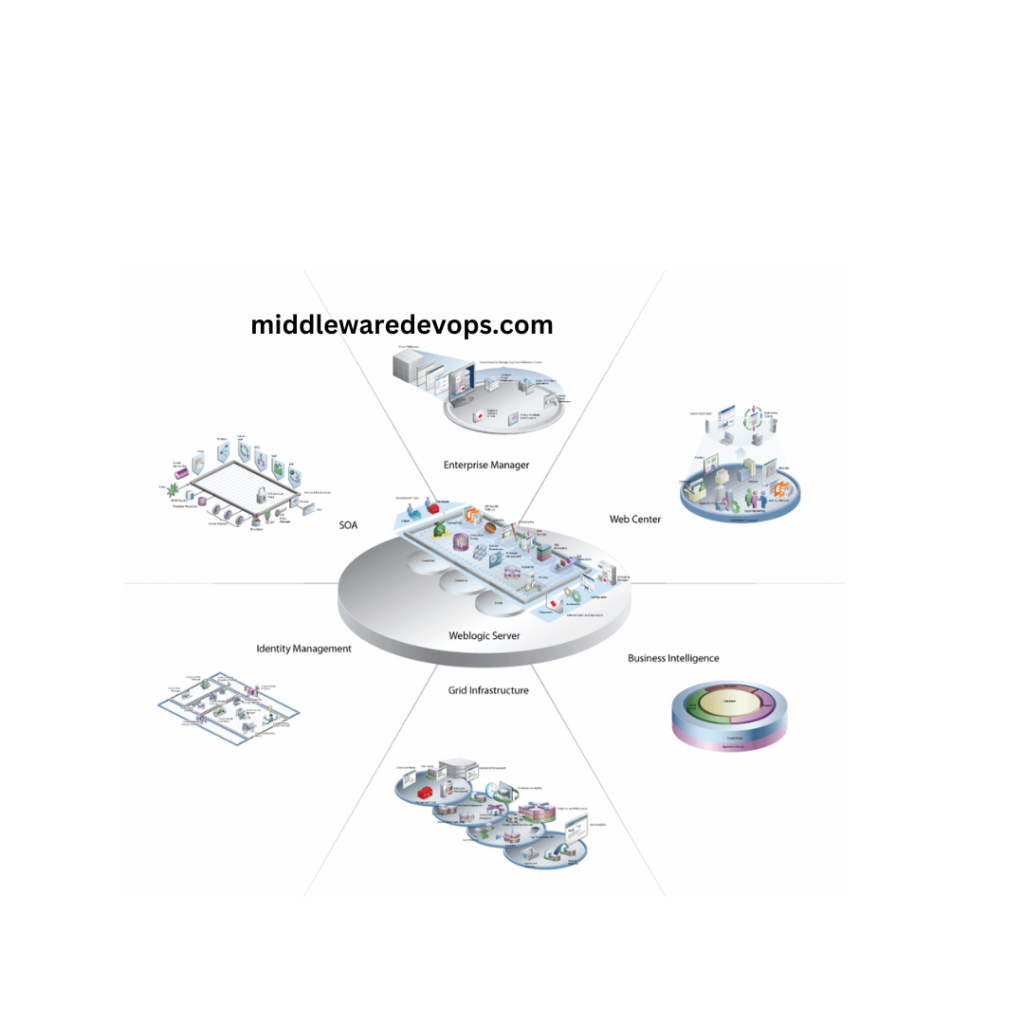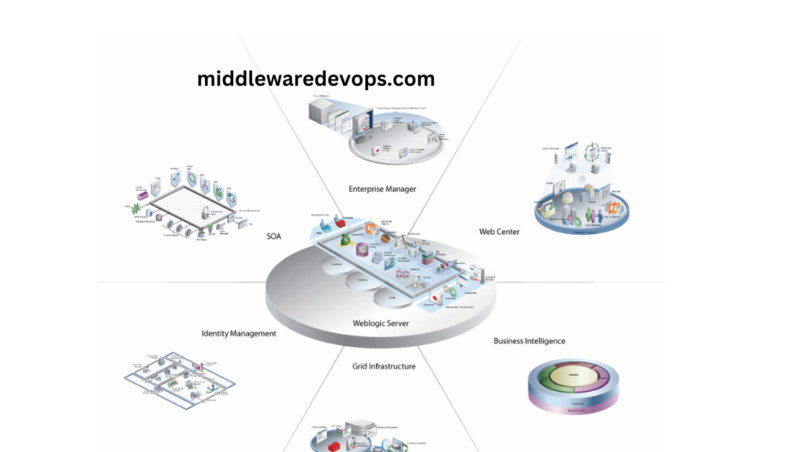Overview:
Middleware is the term which is so common for every IT professional as today many critical applications are hosted through this bridge. In this article, we will explore middleware in depth, including real-world use cases. Lets start with the core definition:
Middleware is a software layer that sits between the operating system and applications and provides services and functionalities that enable communication and interaction between different software components. It serves as a bridge between applications, databases, operating systems, and other computing resources, allowing them to work together seamlessly. Middleware provides a wide range of services, such as data management, application services, messaging, authentication, security, and API management. It helps to reduce the complexity of application development and deployment, increases scalability and flexibility, and facilitates interoperability between heterogeneous systems. Middleware can be implemented in different forms, including web servers, application servers, message-oriented middleware, and enterprise service buses.

Why is middleware important?
Middleware is important for several reasons:
- Integration: Middleware enables communication and integration between different software components or systems, facilitating interoperability and enabling them to work together seamlessly. It helps to connect diverse technologies, platforms, and protocols, allowing systems with different interfaces or data formats to communicate with each other.
- Abstraction and Encapsulation: Middleware provides abstraction and encapsulation, which allows components or systems to interact without having to understand the underlying implementation details. This promotes separation of concerns, modularity, and loose coupling, making it easier to develop, maintain, and evolve complex software applications.
- Reusability: Middleware components are often reusable, providing pre-built functionality for common tasks such as authentication, authorization, logging, caching, and error handling. This saves development time and effort, as developers can leverage existing middleware components instead of building similar functionality from scratch, leading to more efficient and cost-effective software development.
- Scalability and Flexibility: Middleware can help improve the scalability and flexibility of software systems by providing mechanisms for load balancing, distributed processing, and fault tolerance. It enables the development of distributed or multi-tier applications, which can be scaled horizontally across multiple servers or clusters, allowing for better performance, availability, and fault tolerance.
- Interoperability: Middleware promotes interoperability by providing standardized interfaces, protocols, and formats that enable communication and integration across different systems, platforms, or technologies. It allows organizations to integrate new systems or components into their existing IT infrastructure, without having to overhaul their entire architecture, which can save time, cost, and effort.
- Evolution and Future-proofing: Middleware can provide an abstraction layer that insulates applications from changes in underlying technologies, allowing for easier upgrades or replacements of components or systems without affecting the entire application. This helps in future-proofing applications, as it enables them to adapt to changing technologies and requirements without major rework.
By using middleware, developers make the process of designing software applications simpler, as it deals with connectivity between various components and software systems. This leaves them to focus on the business logic and features of their software without having to worry about complex network communications. Without middleware, developers would have to develop a data exchange module for each software component that connects to the application. This is difficult because most modern applications consist of multiple microservices or small software components that interact with each other.
What are the use cases of middleware?
The following are the more common use cases of middleware:
1. Software development:
Middleware is utilized by software developers to effectively manage and integrate various software components into different programs. This often involves using APIs to collect input and generate outputs from these components. Through internal linking, which is hidden from end users, developers can utilize the API of these components to request the services they require from the software.
2. Distributed applications or computing:
Distributed applications refer to software applications that are designed to operate on multiple computers within a network and communicate with each other to accomplish a shared task or provide a service. In a distributed application, various components of the application are executed on different nodes in the network and collaborate to deliver a cohesive user experience. These components can include servers, clients, middleware, and network devices. Communication between the different components of the application is typically facilitated through protocols and interfaces specifically designed for distributed computing, such as Remote Procedure Calls (RPC), Message-Oriented Middleware (MOM), or Web Services.
3. Game development:
Game developers employ middleware, which functions as a game engine, to streamline the development process. This software communicates with different servers for images, audio, video, and communication systems. The game engine facilitates communication, resulting in accelerated game development.
4. Data transmission:
Middleware is utilized by software applications to ensure secure transmission of continuous data streams, which are essential for delivering high-quality video and audio streaming experiences. This includes sending and receiving data streams in a secure and efficient manner.
What are the components of middleware?
Middleware software architecture comprises multiple components that communicate with each other to facilitate data transfer between different applications. The middleware is responsible for handling the data and ensuring compatibility. Typically, these common components are used in combination:
1. Management console:
Administrators and developers can monitor the activities, software rules, and configurations of the middleware system using the management console.
2. Client interface:
Developers utilize functions provided by the client interface to interact with applications, databases, or other microservices.
3. Middleware internal interface:
Within the context of middleware, an internal interface refers to the communication channel that facilitates interaction among different components or services of the middleware within a distributed application. These interfaces are exclusively used by the middleware components and are not exposed to external access. The internal interface can be implemented through protocols such as Remote Method Invocation (RMI), Java Message Service (JMS), or Simple Object Access Protocol (SOAP). The internal interface plays a crucial role in enabling the middleware to perform its functions, such as message routing, resource management, and service provisioning to the applications running on top of it.
4. Platform interface:
The middleware interface is designed to ensure compatibility of a middleware program with various operating systems. It consists of software components that are capable of working with different types of operating systems.
5. Session manager
The session manager establishes a secure connection between an application and the middleware, ensuring smooth communication. Additionally, it logs data activity records and stores them for future reporting purposes.
6. Database manager:
Certain types of middleware also include a database manager, which is responsible for integrating with various types of databases as required.
7. Runtime monitor:
The runtime monitor monitors the data flow within the middleware and alerts developers of any abnormal behaviors or unusual patterns.
How does middleware work?
Essentially, middleware allows developers to create functional applications without the need to customize every connection setup to components, data sources, or computing resources individually, streamlining the development process.
One of the ways in which middleware facilitates this is by providing services that allow different applications and services to use messaging frameworks that are familiar to each other, such as JSON, REST, XML, SOAP, or web services. Additionally, middleware often offers other services that enable components written in different programming languages, such as Java, C++, PHP, and Python, to communicate with each other.
The process typically involves your computer sending a form in XML or JSON format to the web server when you fill it out on a website. The web server then processes the user’s request by gathering data from databases or communicating with other microservices using various protocols.
What is Platform Middleware?
Platform middleware simplifies application development by providing managed tools and resources. Developers use platform middleware to facilitate sharing or exchange of resources between applications. Some examples of platform middleware resources include:
1. Runtime environments:
A runtime environment can be visualized as a small software program that enables the execution of other software on it. For instance, Java applications require the Java Runtime Environment (JRE) to run.
2. Web servers:
A web server is a type of software that serves content, such as web pages, to clients that request it via the internet or a local network. Clients communicate with the web server using the HTTP protocol, and the web server responds by delivering the requested content to the client.
Web servers generally comprise two primary components: the software program and the hardware it runs on. The software program encompasses the core functionality of the web server, while the hardware provides the computing resources necessary to run the software.
Some of the commonly used web servers are:
- Apache HTTP Server: An open-source web server that is highly customizable and compatible with various operating systems, widely used worldwide.
- Nginx: A lightweight and high-performance web server known for its ability to handle a large number of concurrent connections, often used as a reverse proxy server or load balancer.
- Microsoft IIS: The web server included with Microsoft Windows, specifically designed for hosting Windows-based applications, often used for hosting ASP.NET applications.
- Google Web Server: A custom web server used exclusively by Google for serving its web pages, not publicly available for general use.
Web servers can also be utilized in tandem with other software to extend their functionality. For instance, scripting languages such as PHP, Python, or Ruby can be used in conjunction with web servers to dynamically generate web pages. Similarly, content management systems like WordPress or Drupal can be integrated with web servers to provide a framework for building and managing websites.
3. Content management systems:
A Content Management System (CMS) is a software tool that enables users to create, edit, store, and publish content on a website. One widely used example of a CMS is WordPress, which is free to use and requires minimal technical expertise.
Types of Middleware
There are various types of middleware, each with its own focus on connectivity, applications, devices, or component types. Some middleware is designed to provide features for specific development projects. Here are some popular examples of middleware software:
1. Enterprise application integration middleware:
Enterprise application integration middleware acts as a bridge between different data-based systems, web services, and desktop applications, regardless of the operating system. It enables information to be exchanged between these programs without the need to reprogram either the database or the network.
2. Database-oriented middleware:
Data-oriented or database-oriented middleware streamlines the transfer of data between diverse databases and other applications.
3. Message-oriented middleware:
Message-oriented middleware, also known as distributed object request broker or object request broker, facilitates communication between software components on a distributed computing system.
4. Transactional middleware:
Transactional middleware, such as transaction process monitors, ensures the correct execution of each step in a software transaction process.
5. Content-centric middleware:
Middleware that employs content-based logic enables applications to share or display content without the need to handle the underlying storage structure.
6. Application server middleware:
Application server middleware is utilized by application developers to deploy, manage, and establish connections between enterprise applications and backend servers.
7. API management middleware:
API management middleware allows developers to design APIs and expose them to other developers for consumption.
8. Robotic middleware:
Robotics middleware facilitates communication and collaboration among diverse robots, enabling engineers to integrate robots with different designs, hardware, and firmware, and enable them to work together seamlessly.
What is middleware in cloud computing?
Cloud computing involves the development and deployment of cloud-native applications across various infrastructures. Developers can access cloud resources through middleware, which simplifies the management of infrastructures. Cloud-based applications are deployed in containers on scalable cloud hosting. You can browse or go through the below link in order to further understand the Cloud Middleware in-depth.
Takeaway
Overall, middleware plays a crucial role in modern software development by facilitating communication, integration, abstraction, reusability, scalability, and interoperability, making it an essential component in building robust, scalable, and flexible software applications.
By 2026, the global middleware market is expected to reach a staggering $8,700 million, and for good reason. Incorporating middleware requirements into a redesign or existing architecture is crucial for staying ahead in the ever-evolving technological landscape. To thrive, it’s essential to adapt to the latest advancements in technology.
FAQs
What do you mean by middleware?
Middleware refers to software that performs a wide range of common tasks, such as data management, application services, messaging handling, authentication, and API management.
What are the components of a middleware?
The architecture of middleware software typically comprises various components, including a Management Console, Client Interface, Platform Interface, Session Manager, Database Manager, and Runtime Monitor.






